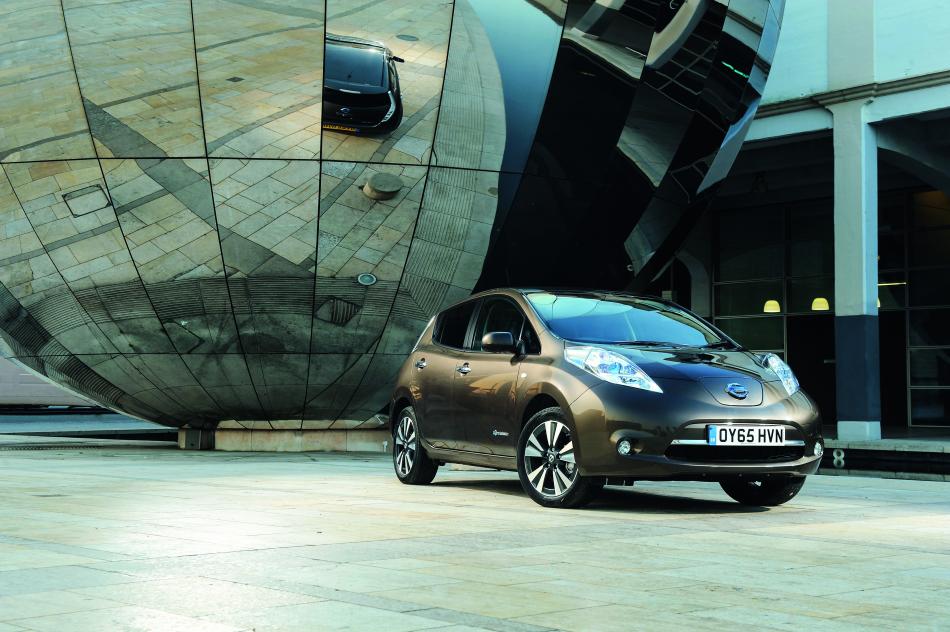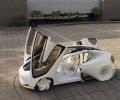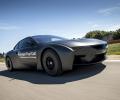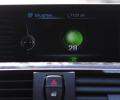From Auto #17: Leading the charge
Marked gains in battery technology mean that electric vehicles could soon be poised to rival sales of the internal-combustion car for the first time in more than a century.

Click here to read the full Auto #17 magazine.
In the late 19th and early 20th century, electric vehicles (EVs) rivalled steam- and internal-combustion-powered cars for outright sales. In fact, in the very early 1900s, more EVs were sold in the US than any other vehicle. They were quiet, did not require drivers to toil with a hand-crank, clutch or gearstick, and limited driving ranges mattered little because they were typically used for short journeys in urban areas.
But with the advent of widespread oil exploration, the introduction of the electric starter motor and Henry Ford’s mass-production techniques, internal-combustion cars became cheaper to buy and run, more practical too.
As a result, electric mobility spent much of the 20th century consigned to history, or the golf course. But during the last seven years electric cars have enjoyed a renaissance, as improved technology, the need to reduce vehicle emissions and government incentives combine.
The Nissan Leaf, Tesla Model S and Renault Zoe have all appeared during this period. Mercedes and Volkswagen were among the manufacturers that announced all-new commitments to the segment at last September’s Paris Motor Show.
And yet the success of electric vehicles remains modest. The Nissan Leaf, the world’s best-selling EV, might have notched up more than 230,000 sales since 2010, but Automotive Industry Data Limited reports that Battery Electric Vehicles (BEVs) account for just 0.6 per cent of all new vehicle sales in Western Europe. The figure could be about to dip below 0.5 per cent after July saw a third consecutive fall in monthly sales.
Batteries remain the nub of the issue. They are responsible for range anxiety, the fear that an EV will run out of power before the driver can find a re-charging station. Batteries also account for around one-third of the cost of building an EV, and therefore contribute heavily to the high prices passed on to EV customers. The Volkswagen E-Up!, for instance, retails at €26,900 in Germany, where conventional models stretch from €9850 to €14,025. Even with healthy government subsidies, EVs command very significant premiums.
These issues are gradually being addressed, however.
Bloomberg reported that battery prices fell by 35 per cent in 2015. Tesla is building a Gigafactory and plans to produce more lithium-ion batteries annually by 2020 than were produced worldwide in 2013, boosting economies of scale and reducing costs. Renault’s business model incorporates re-using EV batteries to store electricity after their usable life powering cars has expired, therefore increasing the batteries’ residual value and reducing lease costs.
Meanwhile, work is rapidly progressing to improve BEV range, in some cases with motor sport as the test bed. Renault sells a full range of EVs, and competes in both Formula E and at the e-Rallye Monte Carlo. Williams Advanced Engineering has provided batteries to all Formula E teams over the last three seasons. AUTO spoke to experts from both companies.
WEIGHT WATCHING
“We have developed the Aston Martin Rapide E luxury saloon and Nissan BladeGlider premium electric sports car concepts, and we’re working on an advanced hybrid battery for a premium car maker,” explains Williams Advanced Engineering technical director Paul McNamara.
McNamara describes the quest to improve battery range at its most basic level as a size and weight trade-off. An electric car battery typically consists of tens or hundreds of cells linked together and rated at Kilowatt hours (kWh); the higher the kWh per kilogramme, the greater the range. As range increases, so batteries generally become larger, heavier and more expensive.
“We’re working on battery packs for premium road cars and they weigh 600-700kg, which is approaching a third of the weight of the car just in the battery,” he says. “Our challenge over the next five to 10 years is to increase battery range up to 400 miles or so, or get the battery pack weight down by 20-30 per cent – it depends on the OEM requirements.”
The battery in the Renault Zoe supermini EV accounts for around 240kg of the overall 1468kg kerb weight.
EV global sales director Guillaume Berthier says that while efficiency gains are being made with batteries, Renault is also targeting the interface between the battery and the electric motor; lessons here are being directly transferred from developments in Formula E, he claims. “It’s a Kaizen approach, with many small improvements contributing to overall gains in efficiency,” he says.
Berthier also sees a future where different battery options are increasingly offered to consumers, as Tesla does today. “We must adapt to different kinds of customers,” he says. “Some will want the highest possible range, even if the price is high, but others will prefer a low price with a smaller range because their daily needs are less. At Renault we focus more on providing cars that everyone can buy.”
Lithium-ion technology looks likely to remain the default choice for the long-term, after superseding nickel-metal hydride as the chemistry of choice for EV batteries.
“Other battery technologies may well appear as disruptive technologies, but they’d have to show substantial benefits as lithium-ion will start to develop an industrial base,” says McNamara. “There are big strides being made across the industry with lithium-ion and we can probably expect Kilowatts per kilogram growth at a base chemistry level of five to six per cent annually. That won’t continue forever, but at the moment the gains remain quite large.”
As much as improved energy density boosts driving range, battery weight plays a role too: the less a car weighs, the less energy it consumes. The corollaries of improved acceleration and agility add further appeal.
“Sixty per cent of a battery pack consists of cells, but 40 per cent is the safety cage for fire and crash protection, the cooling system, the control system and the electrical connectors, which are quite big to handle currents of as much as 5-600 amps,” says McNamara. “You’ve got to have buzz bars with a substantial cross-section of copper to handle that. We’re getting cleverer by learning from the requirements of the duty cycle in motor sport applications; that’s why motor sport is such a great benefit to us.”
“It is important to be efficient and save weight,” adds Berthier. “The more efficient the battery, the fewer cells you have, and therefore the cost and weight is lower. At the moment we are trying to improve range without adding too much weight.”
Electrical and heating and ventilation systems also adversely affect EV range: heating alone can reduce range by up to 20 per cent. The battery is part of the solution, thinks McNamara. “As soon as you start using a battery, it starts warming up. There are strategies for storing heat like this: glorified vacuum flasks, for instance. In an electric car you’ve got almost half of your fuel energy available as thermal energy, and we can use that to heat the car.”
Porsche, meanwhile, is even targeting infotainment systems. The German manufacturer revealed the Mission E electric sports car concept in 2015, which is likely to be specified with premium audio systems. Of the maker’s current vehicles, 80 per cent of customers upgrade to a powerful Bose system, 10-15 per cent to range-topping Burmester audio.
“The next big task is for e-mobility,” says acoustic engineer Matthias Renz. “A 1500W audio system uses energy and reduces driving range. Our latest tweeters have lighter foil and a stronger magnet for more performance and energy efficiency. Every one of the 21 speakers in the Panamera’s Burmester system has its own amplifier. Five are Class-D with 95 per cent efficiency, but the rest are Class A/B amplifiers at 70 per cent. We will increasingly switch to Class D.”
Tangible gains are already filtering through to production EVs. When the Renault Zoe was launched in 2012, its 22kWh battery offered a driving range of 208km on the NEDC cycle. That recently increased to 238km with a more efficient electric motor and control strategy. Then, at the 2016 Paris Motor Show, Renault announced a new 41kWh battery to boost the Zoe to 400km, almost doubling the range in just over four years.
Developed in partnership with LG Chem, the new battery has thicker cells optimised for extra energy density, but remains the same size and weighs only 22kg more.
Tesla Motors, the first to use lithium-ion battery cells, recently unveiled a new 100KwH battery pack for the Model S and Model X. The chemistry of the cylindrical cells – most makers uses pouch cells – remains unchanged, but the battery stores more energy in the same space. As a result, range increases from around 460km to well over 480. Makers hope that increased battery range, together with an ever-expanding charging network – there are more than 60,000 public charging points in Europe – and reduced charge times could entice more buyers into EV ownership. If that happens, so economies of scale will accelerate, reducing the cost of batteries and, therefore, the costs of the cars.
It’s already happening. “We have entered the virtuous circle of battery production,” says Berthier. “There is more and more demand, so more investment and research, and more production, which helps prices to fall.” Bloomberg New Energy Finance reported battery prices falling by 35 per cent in 2015, as worldwide EVs sales increased by 60 per cent. Taking all data into account, Bloomberg predicted that EVs would achieve price-parity with petrol and diesel cars at some point between 2022 and 2028.
Should that analysis prove correct, EVs will be in a strong position to regain the sales crown from internal- combustion vehicles for the first time in a century.

 Facebook
Facebook Twitter
Twitter






